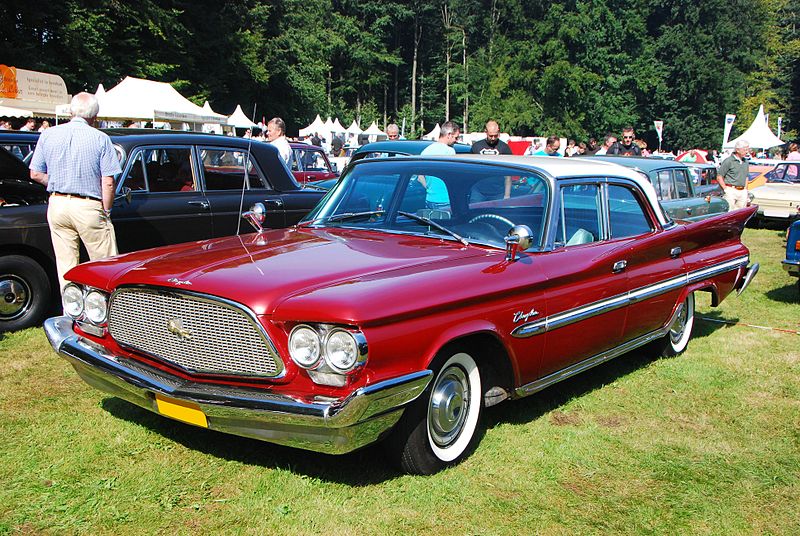We will start this blog series with the
Chrysler Windsor
Some basics:
The Chrysler Windsor was a full-sized car built by the Chrysler Corporation of Highland Park, Michigan (USA) from 1939 through to the 1960s. The final Chrysler Windsor as known to Americans was produced in 1961, but continued production in Canada until 1966. The Canadian 1961 to 1966 Windsor model was for all intents and purposes the equivalent of the Chrysler Newport in the United States.
The Windsor was positioned above the entry-level Royal from 1939 to 1950. With the demise of the Royal for the 1951 model year the Windsor became Chrysler's price leader through to 1960. For the 1961 model year the Chrysler Newport was made the marque's price leader with the Windsor positioned one level above the Newport. Chrysler replaced the Windsor name in 1962 with the introduction of the non-lettered series Chrysler 300. Source Wikipedia
The Windsor was positioned above the entry-level Royal from 1939 to 1950. With the demise of the Royal for the 1951 model year the Windsor became Chrysler's price leader through to 1960. For the 1961 model year the Chrysler Newport was made the marque's price leader with the Windsor positioned one level above the Newport. Chrysler replaced the Windsor name in 1962 with the introduction of the non-lettered series Chrysler 300. Source Wikipedia
Models
 1939-1942
1939-1942The Windsor first came out in 1939.
In 1940, the Windsor came in either long or short wheelbase versions as a 6-passenger sedan, a 6-passenger coupe, a convertible, a Victoria sedan, or an 8-passenger sedan. New this year were sealed beam head lights. The Windsor used independent front suspension, 11" brakes, and a X girder truss type frame.
New for 1941 was the Windsor Six Town and Country, a station wagon type vehicle designed by David A. Wallace, who was the president of Chrysler at the time. Fog lights and bumper crash bars were optional.
Production ended in January, 1942, as all automobile companies in the USA switched to war production. The 1942 heralded post-war design, with fenders being better integrated into the overall bodywork.
1946-1948
After the war, the Windsor was put back into production. It was similar to the 1942 models. New things included a hand brake warning signal that warned that the hand brake was not fully released, and a new grill. Tank capacity was 17USgallons. There was full instrumentation.
1948 Chrysler Windsor
The Windsor made up 62.9% of the company's sales.
1949-1952
In 1949, for Chrysler's 25th anniversary, Chrysler Windsor's were redesigned. The style was boxier than the competition. New this year was a padded dashboard with sponge rubber for safety.
In 1950, the Windsor Traveler Sedan was reintroduced. It only lasted one year. The Windsor still had full instrumentation.
1951, the Royal was dropped, and the Windsor became Chrysler's low-priced car. Front leg room was 41.8". The Windsor DeLuxe had an electric clock standard.
Little changed in 1952. Power brakes were standard on the Windsor DeLuxe 8-passenger sedan.
1953-1954
In 1953, the Chrysler Windsor (along with the rest of the Chrysler line) got new sheet metal and one-piece curved windshield. Power steering was a $177 option.
For 1954, the base Windsor was dropped and all that was left was the Windsor DeLuxe. The grill was new.
1955-1956
In 1955, all Chrysler cars were completely restyled with styling by Virgil Exner. The Windsors were more rounded and had wrap around windshields. The word DeLuxe was added to Windsor again. Front head room was 35 inches (890 mm). Rear axle ratio for the 3-speed manual was 3.73. It made up 64.72% of Chryslers sales.
For 1956, the "Forward Look" restyling was introduced. The first tail fins on a Chryler appeared. Interiores stayed pretty much the same, with the exception of the new Highway Hi-Fi phonograph player, that was optional on the Windsor. Base price was $2,870.
1957-1958
For 1957, Chryler cars, including the Windsor, were restyled again. This time with taller tailfins with vertical taillights, thinner C-pillars, and a wraparound front bumper. Mid-year, dual headlights became standard. Front head room grew to 35.7 inches. Safety equipment was optional on the Windsor. Unfortunally for Chrysler, 1957 cars were plagued with quality problems, such as breaking torsion bars and rust.
In 1958, the Windsor body was moved to the DeSoto Firesweep 122-inch (3,100 mm) chassis. New this year for all Chrysler cars was the new "Auto-Pilot" cruise control system. It had two features. One was the speed-warning feature that the driver would turn the knob to set a certain speed. Then, when the driver would start to pass the speed, pressure would be felt in the pedal, letting the driver know that they were going too fast. The other feature was the actual cruise control. It was activated by pressing on the speed-set knob. The Windsor made up 42.36% of Chrysler's sales in 1958.
1960-1961
In 1960, all Chrysler cars got a unibody frame. A new parking brake was also used. Brakes on the Windsor were 11" drums.
In 1961, all Chrysler cars were redesigned. On the Windsor, standard equipment included a cigarette lighter, map lights, and new for 1961, a safety padded dash. 1961 was the last year of the Windsor in the United States.
Nice 56 Windsor Walk around






No comments:
Post a Comment